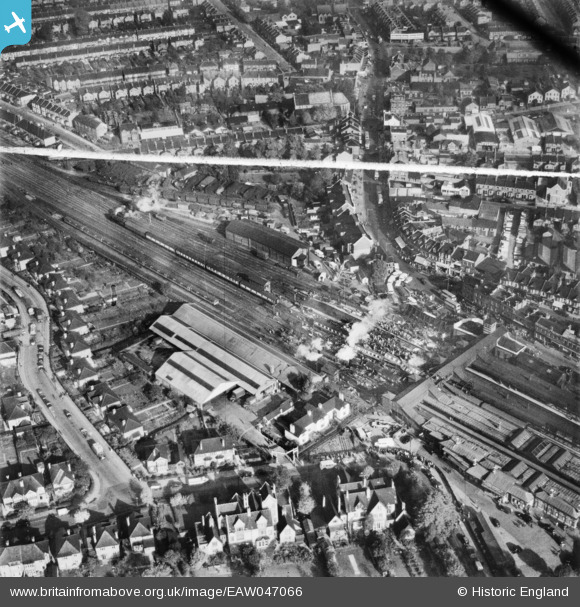EAW047066 ENGLAND (1952). The aftermath of the Harrow and Wealdstone rail crash, Wealdstone, 1952. This image was marked by Aerofilms Ltd for photo editing.
© Hawlfraint cyfranwyr OpenStreetMap a thrwyddedwyd gan yr OpenStreetMap Foundation. 2026. Trwyddedir y gartograffeg fel CC BY-SA.
Delweddau cyfagos (24)
Manylion
| Pennawd | [EAW047066] The aftermath of the Harrow and Wealdstone rail crash, Wealdstone, 1952. This image was marked by Aerofilms Ltd for photo editing. |
| Cyfeirnod | EAW047066 |
| Dyddiad | 8-October-1952 |
| Dolen | |
| Enw lle | WEALDSTONE |
| Plwyf | |
| Ardal | |
| Gwlad | ENGLAND |
| Dwyreiniad / Gogleddiad | 515392, 189524 |
| Hydred / Lledred | -0.33401747141912, 51.592259911112 |
| Cyfeirnod Grid Cenedlaethol | TQ154895 |
Pinnau

John Wass |
Wednesday 4th of March 2015 08:06:34 PM | |

John Wass |
Wednesday 4th of March 2015 07:58:58 PM |
Cyfraniadau Grŵp
The Harrow and Wealdstone rail crash was a three-train collision at Harrow and Wealdstone station in London during the morning rush hour of 8 October 1952. 112 people were killed and 340 injured (88 of these being detained in hospital); it remains the worst peacetime rail crash in the United Kingdom.[1] An overnight express train from Perth crashed at speed into the rear of a local passenger train standing at a platform at the station. The wreckage blocked adjacent lines and was struck within seconds by a "double-headed" express train travelling north at 60 mph (97 km/h). A subsequent Ministry of Transport report on the crash found that the driver of the Perth train had passed a caution signal and two danger signals before colliding with the local train. The accident accelerated the introduction of Automatic Warning System – by the time the report had been published British Railways had agreed to a five-year plan to install the system that warned drivers that they had passed an adverse signal. |

Billy Turner |
Friday 8th of January 2016 09:52:11 PM |


![[EAW047066] The aftermath of the Harrow and Wealdstone rail crash, Wealdstone, 1952. This image was marked by Aerofilms Ltd for photo editing.](http://britainfromabove.org.uk/sites/all/libraries/aerofilms-images/public/100x100/EAW/047/EAW047066.jpg)
![[EAW047065] The aftermath of the Harrow and Wealdstone rail crash, Wealdstone, 1952. This image was marked by Aerofilms Ltd for photo editing.](http://britainfromabove.org.uk/sites/all/libraries/aerofilms-images/public/100x100/EAW/047/EAW047065.jpg)
![[EAW047074] The aftermath of the Harrow and Wealdstone rail crash, Wealdstone, 1952. This image was marked by Aerofilms Ltd for photo editing.](http://britainfromabove.org.uk/sites/all/libraries/aerofilms-images/public/100x100/EAW/047/EAW047074.jpg)
![[EAW047067] The aftermath of the Harrow and Wealdstone rail crash, Wealdstone, 1952. This image was marked by Aerofilms Ltd for photo editing.](http://britainfromabove.org.uk/sites/all/libraries/aerofilms-images/public/100x100/EAW/047/EAW047067.jpg)
![[EAW047083] The aftermath of the Harrow and Wealdstone rail crash, Wealdstone, 1952. This image was marked by Aerofilms Ltd for photo editing.](http://britainfromabove.org.uk/sites/all/libraries/aerofilms-images/public/100x100/EAW/047/EAW047083.jpg)
![[EAW047069] The aftermath of the Harrow and Wealdstone rail crash, Wealdstone, 1952. This image was marked by Aerofilms Ltd for photo editing.](http://britainfromabove.org.uk/sites/all/libraries/aerofilms-images/public/100x100/EAW/047/EAW047069.jpg)
![[EAW047068] The aftermath of the Harrow and Wealdstone rail crash, Wealdstone, 1952. This image was marked by Aerofilms Ltd for photo editing.](http://britainfromabove.org.uk/sites/all/libraries/aerofilms-images/public/100x100/EAW/047/EAW047068.jpg)
![[EAW047070] The aftermath of the Harrow and Wealdstone rail crash, Wealdstone, 1952. This image was marked by Aerofilms Ltd for photo editing.](http://britainfromabove.org.uk/sites/all/libraries/aerofilms-images/public/100x100/EAW/047/EAW047070.jpg)
![[EAW047073] The aftermath of the Harrow and Wealdstone rail crash, Wealdstone, 1952. This image was marked by Aerofilms Ltd for photo editing.](http://britainfromabove.org.uk/sites/all/libraries/aerofilms-images/public/100x100/EAW/047/EAW047073.jpg)
![[EAW047077] The aftermath of the Harrow and Wealdstone rail crash, Wealdstone, 1952. This image was marked by Aerofilms Ltd for photo editing.](http://britainfromabove.org.uk/sites/all/libraries/aerofilms-images/public/100x100/EAW/047/EAW047077.jpg)
![[EAW047078] The aftermath of the Harrow and Wealdstone rail crash, Wealdstone, 1952. This image was marked by Aerofilms Ltd for photo editing.](http://britainfromabove.org.uk/sites/all/libraries/aerofilms-images/public/100x100/EAW/047/EAW047078.jpg)
![[EAW047075] The aftermath of the Harrow and Wealdstone rail crash, Wealdstone, 1952. This image was marked by Aerofilms Ltd for photo editing.](http://britainfromabove.org.uk/sites/all/libraries/aerofilms-images/public/100x100/EAW/047/EAW047075.jpg)
![[EAW047079] The aftermath of the Harrow and Wealdstone rail crash, Wealdstone, 1952. This image was marked by Aerofilms Ltd for photo editing.](http://britainfromabove.org.uk/sites/all/libraries/aerofilms-images/public/100x100/EAW/047/EAW047079.jpg)
![[EAW047076] The aftermath of the Harrow and Wealdstone rail crash, Wealdstone, 1952. This image was marked by Aerofilms Ltd for photo editing.](http://britainfromabove.org.uk/sites/all/libraries/aerofilms-images/public/100x100/EAW/047/EAW047076.jpg)
![[EAW047080] The aftermath of the Harrow and Wealdstone rail crash, Wealdstone, 1952. This image was marked by Aerofilms Ltd for photo editing.](http://britainfromabove.org.uk/sites/all/libraries/aerofilms-images/public/100x100/EAW/047/EAW047080.jpg)
![[EAW047071] The aftermath of the Harrow and Wealdstone rail crash, Wealdstone, 1952. This image was marked by Aerofilms Ltd for photo editing.](http://britainfromabove.org.uk/sites/all/libraries/aerofilms-images/public/100x100/EAW/047/EAW047071.jpg)
![[EAW047082] The aftermath of the Harrow and Wealdstone rail crash, Wealdstone, 1952. This image was marked by Aerofilms Ltd for photo editing.](http://britainfromabove.org.uk/sites/all/libraries/aerofilms-images/public/100x100/EAW/047/EAW047082.jpg)
![[EAW047072] The aftermath of the Harrow and Wealdstone rail crash, Wealdstone, 1952. This image was marked by Aerofilms Ltd for photo editing.](http://britainfromabove.org.uk/sites/all/libraries/aerofilms-images/public/100x100/EAW/047/EAW047072.jpg)
![[EAW047081] The aftermath of the Harrow and Wealdstone rail crash, Wealdstone, 1952. This image was marked by Aerofilms Ltd for photo editing.](http://britainfromabove.org.uk/sites/all/libraries/aerofilms-images/public/100x100/EAW/047/EAW047081.jpg)
![[EPW005359] High Street and Harrow and Wealdstone Station, Harrow, 1921](http://britainfromabove.org.uk/sites/all/libraries/aerofilms-images/public/100x100/EPW/005/EPW005359.jpg)
![[EAW047085] The aftermath of the Harrow and Wealdstone rail crash, Wealdstone, 1952. This image was marked by Aerofilms Ltd for photo editing.](http://britainfromabove.org.uk/sites/all/libraries/aerofilms-images/public/100x100/EAW/047/EAW047085.jpg)
![[EAW047084] The aftermath of the Harrow and Wealdstone rail crash, Wealdstone, 1952. This image was marked by Aerofilms Ltd for photo editing.](http://britainfromabove.org.uk/sites/all/libraries/aerofilms-images/public/100x100/EAW/047/EAW047084.jpg)
![[EPW053686] Harrow and Wealdstone Railway Station, Wealdstone, 1937](http://britainfromabove.org.uk/sites/all/libraries/aerofilms-images/public/100x100/EPW/053/EPW053686.jpg)
![[EPW062566] The Kodak Works and environs, Harrow, from the east, 1939](http://britainfromabove.org.uk/sites/all/libraries/aerofilms-images/public/100x100/EPW/062/EPW062566.jpg)